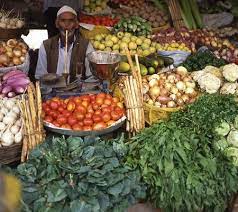In an astonishing turn of events, the humble Kashmiri Haakh, also known as collard greens, has surpassed the price of chicken in the Kashmir region, spotlighting the distressing surge in vegetable prices that is squeezing the wallets of consumers.
A recent market study conducted by Kashmir InFocus has shed light on a significant price differential between wholesale and retail rates, contributing to the steep escalation of vegetable costs in Srinagar’s bustling marketplaces.
To put this into perspective, collard greens are being sold at Rs 120 per kg at the Soura Vegetable Mandi, while chicken is available at Rs 115 per kg, making the startling revelation that chicken is cheaper than this leafy vegetable.
Delving deeper into the issue, the Parimpora Mandi Association, a significant player in the wholesale market, set the price range for this produce at Rs 50 to 60 per kg.
Interestingly, the geographical distance between Parimpora and Soura is a mere 5 to 6 km. However, the cost of collard greens sees an unjustified doubling, much to the dismay of the already strained consumers who diligently allocate their hard-earned money for their basic sustenance. Even the locally grown Kashmiri Saag has fallen victim to this price hike, a stark reminder of the far-reaching impact of this surge.
Yet, the price surge isn’t confined to just one vegetable. The gaping chasm between wholesale and retail pricing is nothing short of astonishing, and what’s more alarming is the apparent lack of oversight from the authorities.
Tomatoes, commanding a retail price of Rs 130 per kg, are sourced at a wholesale rate of Rs 90. Similarly, peas fetch Rs 150 per kg on the retail front, while the wholesale price remains below Rs 100. Other examples include bitter gourd at Rs 120 per kg, local gourd at Rs 70 per piece, brinjals at Rs 80 to 100 per kg, and carrots at Rs 60 per kg.
Apprehensive consumers are increasingly vocalizing their concerns, urging the attention of authorities to rein in profiteers capitalizing on this unfortunate situation, which has triggered an unprecedented surge in vegetable prices across Kashmir.
“Vulnerable consumers are cornered into purchasing items regardless of their exorbitant costs, as their plight remains largely unattended. Regrettably, vegetables, once seen as an affordable alternative, are now beyond the reach of the common populace due to the soaring prices. It’s disheartening that what was once considered a fallback option for those who couldn’t afford meat has now become an unattainable luxury,” expressed Muhammad Shafi, a local resident.
Riyaz Ahmad, the Director of Food, Civil Supplies, and Consumer Affairs (FCS&CA) in Kashmir, pledged firm action against those exploiting the situation to reap excessive profits from the sale of essential commodities.
Meanwhile, Bashir Ahmad Bashir, Chairman of the Fruit Mandi Association, attributed the price hike to a reduced vegetable production caused by inclement weather.
“As monsoon sweeps across India, the external supply of vegetables dwindles during this time of year. The persistent rains have further disrupted production in Kashmir, leading to the recent surge in vegetable prices compared to previous months.”
The lamentable reality of escalating vegetable prices is a stark reminder of the complex interplay between weather conditions, supply chains, and consumer well-being. As the cost of basic sustenance becomes an increasing concern, the onus falls on regulatory bodies to address the imbalance and ensure a fair market for all.






